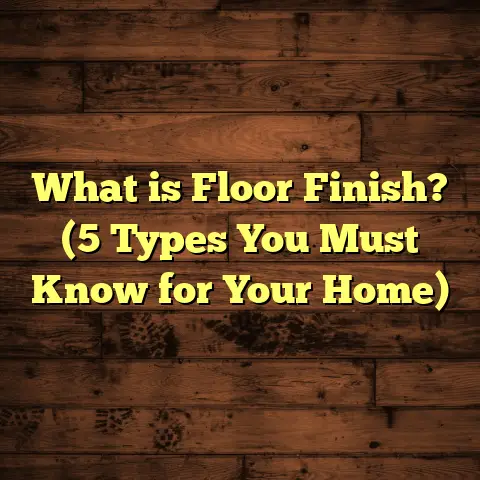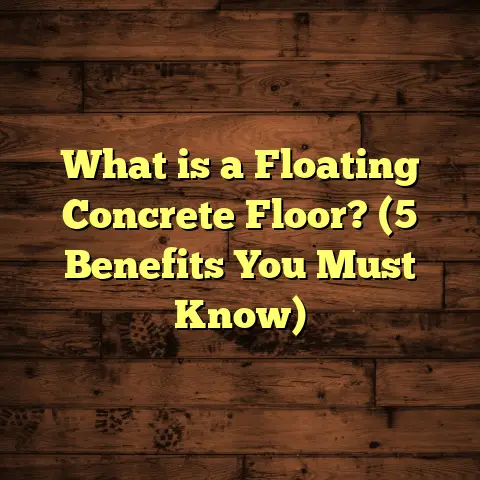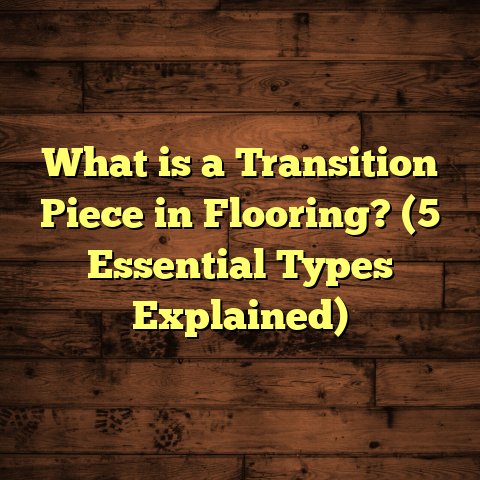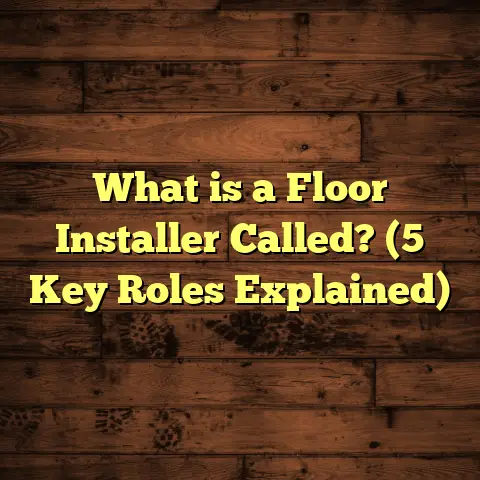What is PVC Flooring? (5 Benefits You Need to Know!)
When I first started working in flooring, one of the first lessons I learned was just how important flooring is when it comes to resale value. I’ve seen homes with worn-out carpets or outdated tile floors struggle to attract buyers, while houses with fresh, well-chosen flooring draw more interest and often sell faster. Flooring isn’t just about how your home looks or feels—it can actually add tangible value when you’re ready to sell.
Over the years, I’ve grown especially fond of PVC flooring. It’s a versatile, cost-effective option that seems to tick a lot of boxes for homeowners and contractors alike. If you’ve heard the term “PVC flooring” but aren’t quite sure what it is or whether it’s right for your home, I’ll break it down for you. We’ll dig into what PVC flooring actually is, how it’s made, its technical specs, and I’ll share some stories and data from my experience.
Ready? Let’s talk PVC flooring.
What Is PVC Flooring?
So, what is PVC flooring? The name stands for polyvinyl chloride flooring. PVC is a type of plastic polymer that’s been around since the early 20th century. When used in flooring, it creates a flexible, durable surface that can be manufactured in sheets, tiles, or planks.
PVC flooring belongs to the category of resilient flooring—meaning it has some flexibility and can absorb impact better than hard surfaces like ceramic tile or stone. This makes PVC comfortable to walk on and helps it resist cracking or chipping.
How Is PVC Flooring Made?
The manufacturing process of PVC flooring is quite fascinating. It starts with raw materials—PVC resin powder mixed with plasticizers (which make the rigid plastic flexible), stabilizers (which protect against heat and UV damage), pigments for color, fillers for strength, and other additives.
The mixture is heated and blended to form a uniform compound. Then comes one of two main forming processes:
- Calendaring: The blend passes between large rollers (like a giant rolling pin) to make thin sheets of uniform thickness.
- Extrusion: The material is pushed through a shaped die to create continuous strips or planks.
After forming the base sheet or plank, manufacturers add several layers:
- Backing Layer: Usually made of foam or felt to provide stability and cushioning.
- Core Layer: The thickest part that gives strength and resilience.
- Design Layer: A printed layer that shows the pattern or texture—wood grain, stone, tile patterns, or even abstract designs.
- Wear Layer: A clear, protective top coat made of polyurethane or similar materials that guards against scratches, stains, and fading.
This layered construction means PVC flooring can be both beautiful and tough.
Different Types of PVC Flooring
PVC flooring comes in several forms:
- Sheet Vinyl: Large continuous sheets that cover the floor without seams.
- Vinyl Tiles: Square or rectangular tiles that mimic ceramic tiles.
- Vinyl Planks: Narrow strips designed to look like hardwood planks with realistic textures.
- Luxury Vinyl Tile (LVT) / Luxury Vinyl Plank (LVP): Higher-end versions with thicker wear layers and more detailed designs.
Each type has its own advantages depending on where you’re installing it and your budget.
Why PVC Flooring Matters for Resale Value
Here’s something I always tell my clients: flooring is one of the first things buyers notice when they walk into your home. It sets the tone for the entire space.
A fresh floor signals care and value. According to a recent report from the National Association of Realtors, updated flooring can increase a home’s resale price by approximately 2% to 5%. That might not sound like much until you do the math: on a $300,000 home, that’s $6,000 to $15,000 added value just from your floors.
PVC flooring fits into this equation perfectly for several reasons:
- It looks modern and clean.
- It resists damage better than many alternatives.
- It comes in styles that appeal to broad tastes.
- It’s affordable enough to replace without breaking the bank but durable enough to last years.
I remember helping a family swap out their old carpet for a wood-look PVC plank floor. Their realtor said it improved the home’s appeal significantly during showings. They sold within two weeks at full asking price.
5 Benefits of PVC Flooring You Need to Know
Now let me share the five biggest benefits I’ve found with PVC flooring based on hands-on experience and research.
1. Durability That Stands Up to Life
One of the first things I look at when recommending floors is durability—how well will it handle daily wear?
PVC floors typically have a wear layer ranging from 0.1mm to 0.7mm thick. That top layer protects against scratches, scuffs, dents, and stains. The thicker the wear layer, the longer and tougher the floor will be.
In a commercial setting I worked on—a busy retail store—the floor took heavy foot traffic from customers and equipment rolling over it daily. Despite this abuse over four years, the PVC floor held up remarkably well with only minor surface wear.
Residentially, PVC withstands pets’ claws, kids’ spills, heels hitting hard surfaces—basically all the stuff that wears down softer floors like hardwood or carpet quickly.
2. Waterproof and Moisture Resistant
If you’ve ever dealt with water damage on wood floors or warped laminate after a spill or flood, you know how frustrating it can be.
PVC floors are almost completely waterproof because water cannot penetrate their dense plastic structure. They resist warping, swelling, and mold growth caused by moisture exposure.
I always recommend PVC in kitchens, bathrooms, laundry rooms, basements—places where moisture is a fact of life.
According to technical data from the Resilient Floor Covering Institute (RFCI), vinyl floors absorb less than 0.1% moisture compared to hardwood’s absorption rate as high as 12%.
This waterproof quality also helps protect subfloors from damage over time.
3. Easy Installation Saves Time and Money
PVC comes in various formats designed for quick installation:
- Peel-and-stick tiles/planks: Great for DIY projects; just peel off backing and stick down.
- Click-lock planks: Snap together without glue or nails.
- Glue-down sheets or tiles: Professional adhesive installation for long-lasting results.
In my experience with both DIYers and pros, these options reduce labor time significantly compared to traditional hardwood or tile installation which often requires specialized tools and skills.
When planning projects, I use FloorTally—a tool that helps me estimate costs based on local labor rates and materials. FloorTally accounts for installation method, material waste percentages, and labor hours so I can give clients accurate budgets upfront. This tool saves me headaches from underestimating costs later on.
Installation speed also means less disruption for homeowners—a big plus if you’re living in the space while renovating.
4. Affordable Without Sacrificing Style
PVC flooring offers an astonishing range of styles at prices far below natural materials like hardwood or stone.
You can find designs that closely replicate wood grains—from oak and maple to exotic species—with textures you can feel underfoot. Stone-look tiles come in marble, slate, granite patterns with realistic color variation.
What amazed me when I compared prices was how much more affordable PVC can be without looking cheap.
Average installed costs range from $2 to $7 per square foot depending on quality and installation method. Compare this to hardwood which often runs $8-$15 per square foot installed.
For budget-conscious homeowners wanting a stylish upgrade without spending a fortune, PVC fits perfectly.
5. Comfort Underfoot and Sound Insulation
One thing people don’t often talk about is how flooring feels when you walk on it all day.
PVC floors have a bit of “give” thanks to their flexible core layers. This cushioning effect reduces foot fatigue whether you’re standing cooking dinner or working in an office space.
I personally noticed this when installing floors in a family’s playroom—the kids were able to play comfortably for hours without hard impacts bouncing back at them like on tile.
Another benefit is noise reduction. Vinyl absorbs sound better than hardwood or laminate because it doesn’t transmit vibrations as easily. This makes it ideal in apartments or homes with multiple levels where noise transfer is a concern.
Technical Details That Matter When Choosing PVC Flooring
To help you get a clearer picture before choosing PVC flooring, here are some technical specs I always check:
| Specification | Typical Range | What It Means For You |
|---|---|---|
| Total Thickness | 2mm – 8mm | Thicker floors usually feel more solid and comfortable |
| Wear Layer Thickness | 0.1mm – 0.7mm+ | Thicker wear layers last longer in high traffic areas |
| Density | Approximately 1.3 – 1.45 g/cm³ | Higher density means stronger material |
| Fire Rating | Class Bfl-s1 (low flame spread) | Meets safety standards for residential use |
| Slip Resistance | R9 – R11 (varies by texture) | Ensures safe footing in wet/dry conditions |
These numbers aren’t just industry jargon—they directly affect how your floor performs day-to-day.
For example, if you want your kitchen floor to resist scratches from dropped pots and pans while still being safe when wet, aim for a minimum wear layer of 0.3mm with an R10 slip rating.
My Personal Experiences With PVC Flooring
I want to share some stories from my work because real-life examples often paint a clearer picture than facts alone.
Story 1: The Busy Family Kitchen
A few years ago, I installed luxury vinyl planks in a family kitchen where kids were constantly making messes and spills were part of daily life. Mom wanted something durable yet warm looking and easy to clean.
We chose a mid-range PVC plank with a textured oak finish and a 0.5mm wear layer. After three years with two toddlers running around plus pets jumping up on floors daily—the floor still looked fantastic with no scratches or discoloration.
Mom told me she loved how quick cleanup was—no worries about water spots like she had with their old hardwood.
Story 2: Retail Store Flooring Challenge
I was called in by a retail client who needed a resilient floor able to handle heavy customer traffic and rolling carts without constant repairs.
We went with commercial-grade vinyl sheet flooring with nearly a 0.7mm wear layer and reinforced backing for stability.
After four years of use—and thousands of visitors—the floor still maintained its appearance with minimal maintenance required. The client appreciated how quick repairs were possible if any tiles got damaged (thanks to modular tile design).
Story 3: Basement Renovation for Rental Property
In another instance, I helped renovate an unfinished basement into a rental unit. Moisture was a concern due to occasional dampness common in basements here.
We selected waterproof vinyl sheet flooring with anti-mold properties and strong adhesive installation.
The tenant reported no issues after two winters despite humidity fluctuations—far better than previous carpeted basements prone to musty smells and stains.
How Using Tools Like FloorTally Helps Me Manage Flooring Projects
Budgeting is one thing many people overlook but it can make or break a flooring project’s success.
I rely heavily on FloorTally because it lets me combine local labor rates with actual material costs and installation specifics all in one place. This makes estimating easier and more reliable compared to guessing or using generic online calculators.
For example, when planning a vinyl plank installation covering 1,000 square feet:
- Floor cost per sq ft: $3.50
- Labor cost per sq ft: $2.00
- Waste factor: 5%
FloorTally calculates total material needed including waste (1,050 sq ft), then multiplies by costs factoring local wages—giving me an accurate total project cost within minutes rather than hours manually crunching numbers.
This upfront clarity helps me talk honestly about what clients can expect financially so there are no surprises mid-project—a huge relief for everyone involved.
Common Questions About PVC Flooring
I get asked lots of questions about PVC floors during consultations. Here are some of the most frequent:
Q: Will PVC flooring yellow over time?
A: Modern PVC products use UV stabilizers that reduce yellowing significantly compared to older vinyl types. However, direct sunlight exposure over many years can still cause slight discoloration depending on product quality.
Q: Can I install PVC flooring over existing floors?
A: Often yes—vinyl sheets or planks can be installed over concrete, wood subflooring, or even existing vinyl if it’s flat and clean. However, always check manufacturer recommendations to avoid issues like trapping moisture underneath.
Q: How do I maintain PVC floors?
A: Simple cleaning routines work best—a regular sweep or vacuum plus mopping with mild detergent keeps floors looking great. Avoid abrasive cleaners or waxes that can damage the wear layer.
Q: Are PVC floors eco-friendly?
A: Vinyl is plastic-based so not biodegradable but many manufacturers now include recycled content in their products and have take-back programs to reduce landfill waste. It’s improving but still not as green as natural materials like wood or cork.
Summing Up What Makes PVC Flooring Stand Out
PVC flooring shines because:
- It balances affordability with durability.
- It handles moisture better than wood or laminate.
- Installation is flexible—DIY-friendly yet professional-grade options exist.
- Style options are vast—from rustic wood looks to modern stone textures.
- Comfort underfoot adds everyday usability.
- It supports sound control in multi-level homes.
- Properly maintained floors retain their appearance for years adding value at resale time.
Final Thoughts And Advice From My Experience
If you’re considering new flooring for your home or rental property—and want something that offers style plus practical benefits—I’d suggest seriously looking at PVC options before deciding on hardwood or carpet.
Ask yourself:
- Do I need waterproof performance?
- Am I on a tight budget but want good looks?
- Will my floor see heavy foot traffic or pets?
- Do I want something easier to install myself?
If you answered yes to any of these questions, PVC might be your perfect fit.
And don’t stress about estimating costs—tools like FloorTally make planning easier by giving realistic budgets based on your exact project details rather than wild guesses.
Remember my client who sold fast after installing vinyl plank floors? That kind of success happens because buyers appreciate floors that look fresh and require little upkeep—exactly what PVC delivers consistently over time.
If you have questions specific to your project or want tips on installation techniques tailored for your space—feel free to reach out anytime! Helping folks find great flooring solutions is why I love this work so much.





